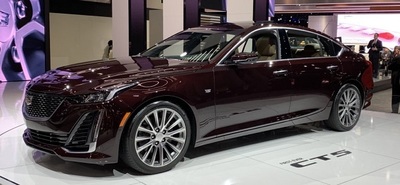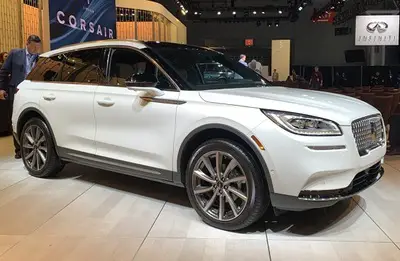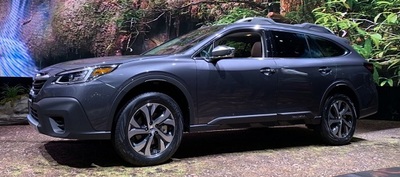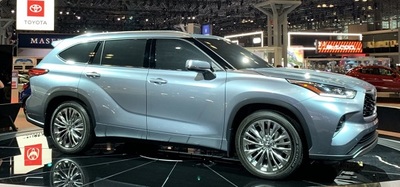LMC At NY Auto Show
 |
SEE ALSO Automotive News NY Auto Show Coverage
Special To The Auto Channel
By Augusto Amorim, Senior Manager, North America Sales
LMC Automotive
New York is synonymous with Broadway shows, skyscrapers, Wall Street and Central Park. Cars, on the other hand, tend to evoke the city’s traffic jams or its iconic yellow cabs. But, in fact, the country’s largest city is also its largest auto market – and a critical market for the Premium segment. New York represents about 6% of US sales, but 11% of Premium sales.
It comes as little surprise then that OEMs unveiled some important new products at the 2019 New York International Auto Show. Below are some of the highlights of this year’s event.
Cadillac
Although its mainstream sister brand Chevrolet will largely abandon the Car market, Cadillac is in the midst of restructuring its sedan portfolio. The CT5 is the spiritual successor to the CTS, but will be positioned in the same segment as the ATS. The new Compact Premium Car will share some of the features offered in the CT6 Midsize sedan, with Super Cruise being key amongst them. The system enables drivers to travel hands-free on more than 130,000 miles of limited-access freeways in the US and Canada. Cadillac may not have the same kudos as Tesla, but offering Super Cruise may improve its image as a more technologically advanced brand. However, the CT5 will not offer any kind of electrification. Its standard powertrain is a 2.0L turbo engine paired with a 10-speed transmission, while the 3.0 V6 engine is available in the more expensive trim levels. As consumer preference continues to gravitate towards SUVs, we forecast CT5 sales to peak at around 12,000 units, in line with the levels achieved by both the CTS and ATS in 2018.
Genesis
Still a minor player in the Premium segment, with only three sedans in its portfolio, Genesis is experimenting with the Mint concept car. The 2-seater is the brand’s interpretation of an urban car. “Size is no determinant of luxury”, believes Manfred Fitzgerald, Genesis’ global head. He also points out that no other brand is present in the segment, but may have forgotten that Aston Martin never brought the Cygnet to the US. “The reaction has been overwhelmingly positive”, he said about the Korean EV. While the Mint seems more of an exercise than anything else, Fitzgerald confirmed that Genesis’ next actual release would be the GV80 Midsize Premium SUV, which is due to launch in South Korea in Q4 2019 and in the US in Q1 2020.
Hyundai
Among the 40 million used-vehicle buyers, Hyundai has identified that many start out looking for a new model, but are unable to afford one. This prompted the Korean OEM to launch a new Small SUV, the Venue. However, it started selling another Small SUV, the Kona, just last year. To avoid cannibalisation, Hyundai made the Venue shorter, narrower and taller than the Kona. It will also limit the Venue’s trim levels and reserve some features for the Kona, although the Venue will offer an 8-inch navigation system, rear-view monitor, lane-keep assist and driver-attention warning. Even if the Kona is not greatly impacted by the Venue, the new model could hurt the Accent Small sedan, admitted Brian Smith, Hyundai’s COO. Another problem is the constant threat of tariffs. The Venue will be imported from South Korea and a 25% import tax would diminish its affordability. “The tariff affects all products, all the industry”, Smith told LMC Automotive. The Venue will hit the market in the autumn and we forecast total sales of 36,000 units next year. Price will influence the level of interaction between the Venue, Kona and Accent, but we expect sales of the Kona and Accent to fall by 18% and 12%, respectively, in 2020.
Kia
The HabaNiro Concept was developed to showcase Kia’s EV knowhow. The 4-seater is all electric and all-wheel drive. It offers 300 miles of range and Level 5 autonomy. Of course, the four butterfly doors will not make into a production model (they never do) and Level 5 autonomy seems a distant reality, especially for a Small model (the necessary hardware is estimated to cost US$100,000). But the HabaNiro is an important exhibit for the Korean brand as it strives to shed its reputation as a manufacturer of cheap vehicles. Another attempt at rehabilitating its image is the Stinger Midsize Car. The company will build 800 units, with a new all-wheel drive system that adds drift mode. Every model will be orange.
Lincoln
Following its strategy to abandon alphanumeric names, Lincoln revealed the Corsair, which replaces the MKC Compact Premium SUV. Named after the Latin word for journey, the Corsair will be powered by two turbocharged gasoline engines and will feature five different driving modes to adjust the suspension. The model inherits the MKC’s role of attracting younger buyers to the brand through its rounded corners and innovative technology – including the option to substitute the ignition key with a mobile phone app. But it will also inherit a lack of brand appeal from its predecessor. Sales of the MKC were two to three times lower than those of its German and Japanese competitors, and the Corsair is unlikely to do much better. Demand for the Corsair is projected at around 30,000 units next year, compared to 65,000 for the Acura RDX and Audi Q5, respectively.
Mercedes-Benz
The German brand has dubbed 2019 ‘the year of the SUV’. The GLC Compact Premium SUV and its coupé version will offer a slightly renewed design; the all-new GLE Midsize Premium SUV will launch in late summer; and the New York show provided the backdrop for the refreshed GLS Large Premium SUV. With the US representing a third of global GLS sales, Mercedes-Benz has seen numbers plunge as the model ages and competition escalates. Last year, sales dropped by 32% and the GLS struggled to retain its market leadership. BMW just launched the X7 – which sold more than 2,000 units in its first month – and we expect an influx of Super-Premium models to fight for the wealthiest consumers. To lure these buyers, Mercedes-Benz is betting on the notion that more is better. The wheelbase is 2.4 inches longer to offer more interior room, while a 4.0L V8 engine, with the extra boost from a 48V battery, offers 483 hp and saves 20% of fuel. We believe that these changes will support an increase in sales from 20,000 this year to 35,000 in 2020.
Subaru
The Japanese brand’s success story in the US has been remarkable, with March marking the 88th month of year-on-year growth. Much of this has been driven by the Outback Midsize SUV, Subaru’s bestseller in the US market. Now built on the Subaru Global Platform, the Outback offers more protection for passengers – the new body absorbs 40% more energy in front and side crashes. The Outback also gets adaptive cruise control with lane centering, a front-view monitor and a distraction mitigation system capable of identifying if the driver is distracted, using infrared camera and facial recognition technology. And the tablet-sized, high-resolution touchscreen that dominates the dashboard could certainly provide a distraction.
Toyota
While its main rivals continue to migrate away from the Car segment, Toyota has made it abundantly clear that it will not follow suit, as evidenced by the Yaris Small Car. Although sales plunged by 78% in 2018, the new generation will arrive from France in the autumn, and promises to be fun, efficient and affordable. The model will offer features such as a rear-view camera, Apple Car Play and keyless entry. Developing new Cars does not, however, mean that Toyota is giving up on SUVs. Toyota’s second most popular SUV, the Midsize Highlander, is now built on the TNG-K platform and has had 2.5 inches added to the wheelbase to improve interior room, compared with the outgoing model. The 3-row SUV will offer features such as a 12.3” touchscreen, WiFi connection, Amazon Alexa and hands-free power liftgate. As Toyota continues to push hybrid options across its entire model range, the Highlander will pair an electric motor with all-wheel drive for the first time.











